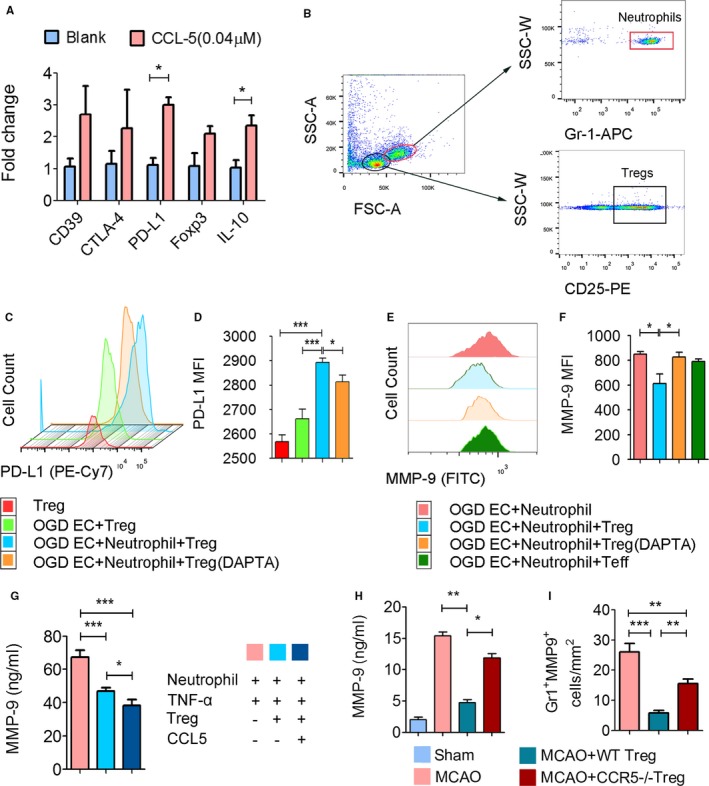Figure 8.

CCL5 expression by Tregs enhances their immune inhibitory function on neutrophils. A, RNA exacts were prepared from Tregs treated with CCL5 (0.04 μmol/L at 37°C for 2 hours). mRNA levels of PD‐L1, CD39, CTLA‐4, Foxp3, and IL‐10 were detected by real‐time polymerase chain reaction and expressed as fold change compared to PBS‐treated controls (blank). n=3 to 4/group. B through F, Tregs and neutrophils were seeded into in vitro cultured mouse endothelial cells challenged with 4 hours of oxygen glucose deprivation (OGD). After another 4 hours of coculture, cells were collected for flow cytometry. Pharmacological inhibition of CCR5 on Tregs was achieved by pretreatment with DAPTA (100 ng/mL) at 37°C for 2 hours. B, Gating strategy of neutrophils and Tregs. n=5 to 7/group. C, Representative histogram of PD‐L1+ cells among Tregs gated from the cocultured cells. D, Mean fluorescence intensity (MFI) of PD‐L1 on Tregs. E, Representative histogram of MMP‐9+ cells among Gr1+ neutrophils gated from the coculture cells. F, MFI of MMP‐9 on neutrophils. G, Tregs treated with or without CCL5 were cocultured with TNF‐α–challenged neutrophils. MMP‐9 level in the culture medium was quantified by enzyme‐linked immunosorbent assay (ELISA). n=6/group. H, Peripheral plasma was collected from sham or transient middle cerebral artery occlusion MCAO mice treated with wild type (WT) or CCR5−/− Tregs for MMP‐9 ELISA measurement. n=6/group. CCR5−/− Tregs failed to inhibit the MMP‐9 rise in MCAO mice. I, Quantification of MMP‐9+Gr1+ neutrophils in the brain slices collected from WT Treg‐ or CCR5−/− Treg‐treated stroke mice at 3 days after MCAO. Adoptive transfer of wild type Tregs, but not CCR5−/− Tregs, significantly reduced MMP‐9 expression in infiltrated neutrophils. *P≤0.05, **P≤0.01, ***P≤0.001. CCR5 indicates C‐C chemokine receptor type 5; DAPTA, D‐ala‐peptide T‐amide; Treg, regulatory T cell, FSC‐A, forward scatter area; SSC‐A, side scatter area; SSC‐W, side scatter width.
